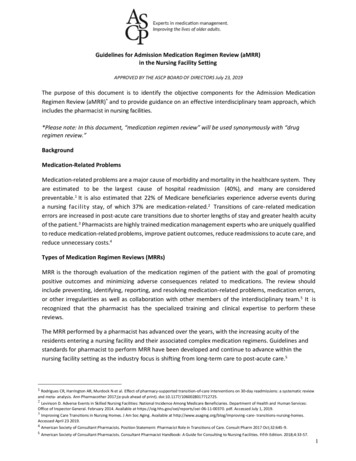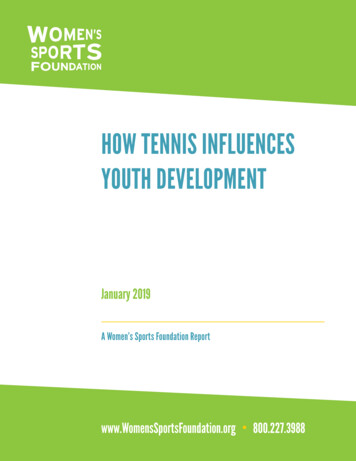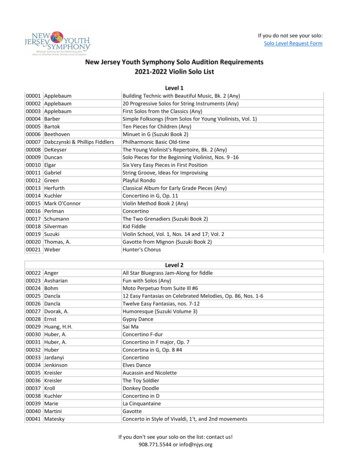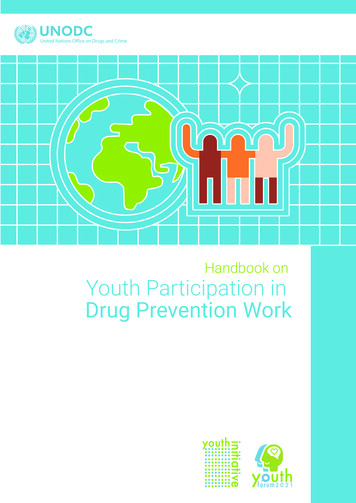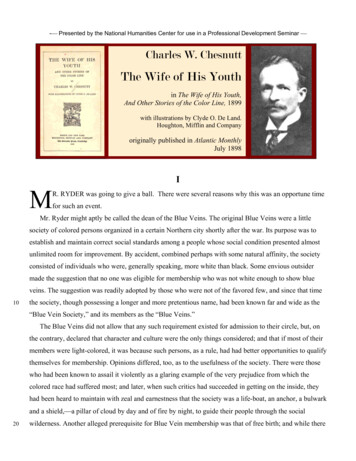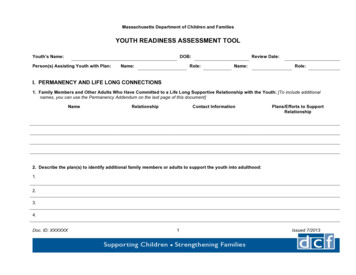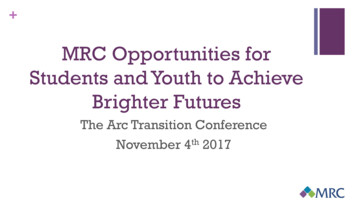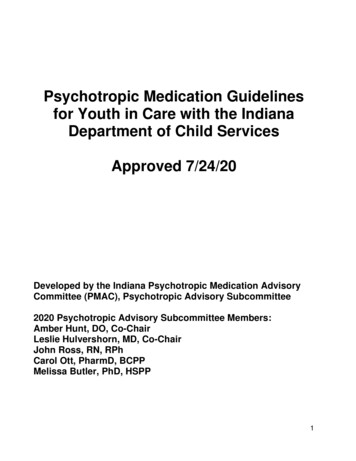
Transcription
Psychotropic Medication Guidelinesfor Youth in Care with the IndianaDepartment of Child ServicesApproved 7/24/20Developed by the Indiana Psychotropic Medication AdvisoryCommittee (PMAC), Psychotropic Advisory Subcommittee2020 Psychotropic Advisory Subcommittee Members:Amber Hunt, DO, Co-ChairLeslie Hulvershorn, MD, Co-ChairJohn Ross, RN, RPhCarol Ott, PharmD, BCPPMelissa Butler, PhD, HSPP1
About the Indiana Psychotropic Medication Advisory Committee (PMAC)The Indiana Psychotropic Medication Advisory Committee (PMAC) was launched inJanuary, 2013 to review the psychiatric treatment of DCS-involved youth, with a specificfocus on psychotropic medication utilization patterns. This committee includesrepresentatives from IUSM Department of Psychiatry, DCS, OMPP, DMHA, pediatricians,social workers, psychologists, pharmacists, child advocates and other identifiedstakeholders (see 2014 members below; see current, 2018 members below). The PMACmonitors Federal legislation, reviews best-practice guidelines for psychotropic medicationuse, monitors Indiana prescription patterns, reviews formularies and makes policyrecommendations to DCS. Specific responsibilities of the committee include the following: Review the literature on psychotropic medication best practice (e.g., AACAP) andprovide guidance to DCS, OMPP, IUSM and prescribing providers; Provide assistance to DCS in establishing a consultation program for youth in statecare who are prescribed psychotropic medications; Publish guidelines for the utilization of psychotropic medications among DCSinvolved youth, with revisions made on a semi-annual basis, as needed; Review DCS policies for requesting and obtaining consent to treat DCS-involvedyouth with psychotropic medications and make recommendations for change toDCS Permanency and Practice Support Division; and Identify non-pharmacologic, evidence-based mental health treatments for DCSinvolved youth.Founding (2014) PMAC Members:Elayne Ansara, PharmD, Pharmacist, Roudebush VAMCSirrilla Blackmon, Deputy Director, Division of Mental Health and AddictionChar Burkett-Simms, Regional Manager, Indiana Department of Child ServicesMelissa Butler, PhD, Clinical Psychologist, LaRue Carter State HospitalCathy Graham, Executive Director, Indiana Association of Resources and Child AdvocacyJames Hall, PhD, LCSW, Professor of Pediatrics and Social Work, IUSMLeslie Hulvershorn, MD, Child Psychiatrist, Department of Psychiatry, IUSMReba James, Deputy Director, Indiana Department of Child ServicesJanice Klein, Chief Operations Officer, Children’s Bureau, Inc.Thomas Lock, MD, Developmental-Behavioral Pediatrician, Riley HospitalSuman Narasimhamurthy, MD, Child Psychiatrist, Aspire CMHCJohn Ross, RN, RPh, Pharmacist, Office of Medicaid Policy and PlanningTy Rowlison, PhD, Clinical Psychologist, Indiana Department of Child ServicesJennifer Tackitt, Program Director, Options Behavioral Health SystemsKelda Walsh, MD, Child Psychiatrist, Department of Psychiatry, IUSM2
2020 PMAC Members:Eleanor Berry, Indiana Department of Child Services, Evaluation & OutcomesSirrilla Blackmon, Deputy Director, Division of Mental Health and AddictionsMelissa Butler, PhD, Clinical Psychologist, Department of Psychiatry, IUSMChris Daley, Executive Director, Indiana Association of Resources and Child AdvocacyAnn Davis, Director of Engagement, Indiana Association of Resources and Child AdvocacyLynn Doppler, COO, Youth Opportunity CenterMelaina Gant, Indiana Department of Child Services, Director, Education ServicesMatthew Gooding, Indiana Department of Child Services, Assistant Deputy DirectorNatalie Haidle, Choices Coordinated Care Solutions, Care CoordinatorEmily Hancock, FSSA, Chief Pharmacist, Office of Medicaid Policy and PlanningLeslie Hulvershorn, MD, Child Psychiatrist, Department of Psychiatry, IUSMReba James, Choices Coordinated Care Solutions, Foster Care DirectorLeslie Miller, Indiana Department of Child Services, Assistant Deputy Director of Social &Emotional WellnessHeidi Monroe, Deputy Director, Indiana Department of Child Services, PPS DivisionChristine Negendank, Adult and Child, Chief Medical OfficerCarol Ott, PharmD, BCPP, Clinical Professor of Pharmacy Practice, Purdue UniversityMartin Plawecki, MD, Child Psychiatrist, Department of Psychiatry, IUSM/ Indiana AACAPDavid Reed, Deputy Director, Indiana Department of Child ServicesJohn Ross, RN, RPh, Pharmacist, Office of Medicaid Policy and PlanningSonya Rush, Indiana Department of Child Services, Assistant Deputy Director ofPermanency and Practice SupportSarah Sailors, Deputy Director, Indiana Department of Child ServicesNicola Singleton, Indiana Department of Child Services, PPS Administrative AssistantRuth Sobieralski, MSW, LCSW, Integrated Care Manager, Indiana Department of ChildServicesJulie Stewart, Child Welfare Service Line, Adult and ChildJennifer Tackitt-Dorfmeyer, Indiana Executive Director, Choices Coordinated CareSolutionsVinluan, Nancy, Campagna Academy, Director of NursingWaibel, Jeff, Gateway Woods, Director of Residential ServicesWashington, Valerie, FSSA, Administrative Assistant, DMHA Youth ServicesVinita Watts, MD, Child Psychiatrist, Centerstone of Indiana3
Table of ContentsIntroduction .page 5Modifications/Clarifications page 5General Principles .page 5-6Medication Specific Recommendations .page 6-7Additions .page 7General Principles .page 7Medication Specific Recommendations .page 7Psychotherapy .page 7Criteria Indicating Need for Further Review page 8-9Tables page 10-14References .page 15Appendix:I. Psychotropic Medication Utilization Parameters for Children and Youth in FosterCare, 65th Version, June 2019 (for Texas Department of Family and ProtectiveServices)II. Butler, M., & Curtin, M. (September 2019). “Therapy Cheat Sheet”. IndianaUniversity School of Medicine, Indianapolis, IN.4
Introduction:In an attempt to provide improved utilization of psychotropic medications and thereforeoverall mental health care to Indiana’s children in the placement and care of theDepartment of Child Services (DCS), DCS convened a work group in 2013 to lead thiseffort. To guide Indiana’s prescribers, this work group, the Indiana PsychotropicMedication Advisory Committee (PMAC) agreed to adopt the September 2013 version ofthe Psychotropic Medication Utilization Parameters for Children and Youth in Foster Care(“Texas parameters;” TP) developed by the Texas Department of Family and ProtectiveServices and The University of Texas at Austin College of Pharmacy (for current version,see Appendix I). To consider the applicability of the Texas parameters, the PMAC taskedits Psychotropic Advisory Subcommittee with a review of the Texas parameters. As aresult of this review, the Subcommittee recommended adoption of the Texas parameterswith the following modifications/clarifications and additions.In February, 2015, upon the recommendation of the Indiana Medicaid Mental HealthQuality Advisory Committee (MHQAC), the Indiana Medicaid Drug Utilization Review(DUR) Board approved exempting drug therapy regimens, based upon recommendationsfrom the IUSM Department of Psychiatry, from prior authorization (PA). Subsequently,managed care entities (MCEs) administering pharmacy benefits for affected youth agreedto participate in this program and adopted the PA exemption process.A first revision was completed January 2016. A second revision incorporated updatedTexas parameters (Version 5), January 2018. This current revision incorporates updatedTexas parameters (Version 6), June 2019.I. Modifications/Clarifications:General Principles:1. In the state of Indiana, a comprehensive evaluation prior to the use of medicationsshould be performed by a licensed professional or a qualified professional under thesupervision of a licensed professional.2. To clarify, a physical examination is not typically completed by a child psychiatrist ornecessarily required for the use/start of psychotropic medications (excludingevaluation for extrapyramidal or other movement side effects). If warranted, it is theresponsibility of the evaluating mental health professional to refer the child for aphysical examination.3. A standardized trauma assessment (e.g., CANS, Trauma Symptom Checklist) ispreferred for clinical assessment of exposure to trauma and maltreatment. Foryouth with more extensive trauma histories, a comprehensive trauma assessmentmay be recommended by DCS. The service standard for comprehensive traumaassessments can be found at http://www.in.gov/dcs/3159.htm.4. In addition to the need to identify DSM-5 diagnoses to direct treatment, diagnosesoutlined in the relevant version of the International Classification of Diagnoses (e.g.,ICD-10) are also appropriate.5
5. Rating scales used to aid in diagnosis and identify response to treatment can beidentified in numerous sources. A number of evidence-based questionnaires/ratingscales can be found at the following link: https://projectteachny.org/rating-scales/6. In addition to diagnoses, benefits/risk, lab findings, adverse events, alternatives,and risks of no treatment, informed consent to begin a psychotropic medicationshould also include expected duration of use and a discussion of possiblemedication interactions.7. If a child does not improve in the care of a non-child psychiatrist, TP recommendsreferral to a child psychiatrist. We would like to clarify that the window for expectedimprovement for most childhood psychiatric disorders is 3 months.8. When treating youth with medication for aggression, TP recommends a slow taperwith discontinuation every 6 months. To clarify, youth with aggression resulting fromany of the following disorders should be given an opportunity for a taper:oppositional defiant disorder, conduct disorder, disruptive mood dysregulationdisorder, developmental disabilities and autism spectrum disorder. We would like tofurther note that such tapers may not be routine in current clinical practice, but theyare now highly recommended.Medication-Specific Recommendations:1. Although short acting alpha agonists for use in the treatment of ADHD and tics arenot FDA approved, they remain the recommended first line agents.2. See Tables for additions3. Routine lipid screening is recommended annually, rather than every 6 months, asoutlined in the TP. If abnormal values are detected, more frequent monitoring(every 3-6 months) is recommended.4. Fasting lipids and glucose are recommended to be checked on every pediatricpatient prior to starting (or at first contact if medication has already been started)medications known to impact these labs (e.g., antipsychotics).5. Although discontinuing an atypical antipsychotic (AAP) in adolescents withmetabolic abnormalities is recommended, if the AAP is deemed essential fortreatment then a trial of metformin may be helpful. Metformin is FDA-approved asan adjunct to diet and exercise to treat type 2 diabetes in patients 10 years of ageand older and has evidence for reducing body-mass index in children ages 10-17without diabetes.6. Recommend vitamin D monitoring for any patient on an anticonvulsant. Initial levelsshould be drawn at 6 months and if deficient at first level, supplement and monitorevery 3 months until normal. If not deficient would recommend monitoring annually.7. Obtain a baseline and annual EKG with use of any antipsychotic and/or with usingtwo or more QTc prolonging agents concurrently.8. Evaluation of blood pressure, heart rate, weight and height is recommended forevery medication monitoring visit and initial evaluation.9. Clomipramine is recommended for obsessive compulsive disorder if the child oradolescent has failed two complete trials of serotonin reuptake inhibitors.10. Due to concerns about the potential for cardiac conduction abnormalities,citalopram should not be prescribed at doses greater than 40 mg daily.11. Orap (pimozide) should be used for the treatment of tics only if haloperidol use wasa failure or intolerable.12. Aripiprazole dosage for the treatment of tics is as follows (per package instructions):6
Patient Weight 50 kg / 50 kgStart dose2 mg2 mgRecommended dose5 mg10 mgMaximum dose10 mg20 mgIII. Additions:General Principles:1. Bipolar Disorder and Schizophrenia are very rare in children ( 13 years old) andthese diagnoses should be made strictly following DSM-5 criteria. For children andadolescents with histories of complex trauma, Autism Spectrum Disorder,developmental delays/intellectual disabilities, and/or substance use, symptomsconcerning for Bipolar Disorder and Schizophrenia should be evaluated carefullywithin the context of these factors.2. Evidence does not support routine clinical use of pharmacogenomic testing andpharmacogenomic guidance should not replace evidence-based medicine.3. Medication “washouts” (abrupt discontinuation of all psychotropic medications,either by a provider or caregiver) are not recommended.Medication-Specific Recommendations:1. Given problematic weight gain among youth on psychotropic agents, diet andexercise counseling with referrals to primary care physicians, dieticians andspecialized pediatricians is recommended for any child with weight changes, ideallyearly in the treatment course.2. Conversely, youth on stimulants who are unable to gain weight at a rate appropriatefor age should be assessed for stimulant dosage reduction or discontinuation.Dietary counseling is recommended.Psychotherapy:In addition to ensuring that children and adolescents in the DCS system are receivingappropriate and evidenced based pharmacologic treatment for their mental healthdisorders, it is equally important to ensure that children who are also receivingpsychotherapy interventions are receiving interventions that are also evidenced based andempirically supported. For information about specific psychotherapy approaches theDivision 12 of the American Psychological Association maintains an easily accessibleresource list of different treatment approaches at tments/. The Society of Clinical Child and Adolescent Psychology alsomaintains a website that provides descriptions of different evidenced based psychotherapyinterventions for children and adolescents. The website also has links to videosdemonstrating each of these approaches so that case managers, caregivers, and medicalproviders can know what to expect when a child or adolescent is participating in a certaintype of psychotherapy treatment. This website can be found at:https://effectivechildtherapy.org/therapies/. Case-managers, psychiatrists, and othermedical providers can also help ensure that quality, evidenced based therapy services arebeing provided by asking helpful questions about therapy services during medical visitsand check-ins. Examples of the types of questions that might be asked during a medicalvisit or check-in are included in Appendix II.7
Criteria Indicating Need for Further Review of a Child’s Clinical StatusThe following situations indicate a need for review of a patient’s clinical care. Theseparameters are the comprehensive criteria for the state of Indiana and differ from those setout in the TP on pages 9-10. These parameters do not necessarily indicate that treatmentis inappropriate, but they do indicate a need for further review.For a child being prescribed a psychotropic medication, any of the followingsuggests the need for additional review of a patient’s clinical status:1. Absence of a complete DSM-5 (or comparable ICD-10) diagnosis in the youth’smedical record2. Four (4) or more psychotropic medications prescribed concomitantly3. Any psychotropic medication prescribed to a child less than one (1) year of age4. Prescribing of: Stimulants to a child less than three (3) years of age Antipsychotics to a child less than five (5) years of age Antidepressants to a child less than four (4) years of age Mood stabilizers to a child less than four (4) years of age Alpha Agonists to a child less than four (4) years of age5. The psychotropic medication dose exceeds usual recommended doses (FDA and/orliterature based maximum dosages).6. The prescribed psychotropic medication is not consistent with the appropriate carefor the patient’s diagnosed mental disorder or with documented target symptomsusually associated with a therapeutic response to the medication prescribed.7. Psychotropic polypharmacy (2 or more medications) for a given mental disorder isprescribed before utilizing psychotropic monotherapy.8. Antipsychotic medication(s) prescribed continuously without appropriate monitoringof glucose and lipids at least every 6 months.9. Prescribing of: Two (2) or more concomitant stimulants* Two (2) or more alpha-2 agonists, including the combination of short- andlong-acting agents (i.e. clonidine ER plus clonidine immediate release ) Two (2) or more concomitant antidepressants, with the exception ofconcomitant antidepressant therapy in which one of the drugs is trazodone 150 mg/day. Two (2) or more lithium-based agents Three (3) or more concomitant lithium-based mood stabilizers or other moodstabilizers (e.g., anticonvulsants) Two (2) or more antipsychotics Three (3) or more sedative-hypnotics8
Two (2) or more benzodiazepines Any long acting injectable antipsychotic Excessive (2 weeks of 4 or more days with PRN use) or inappropriate (3 ormore at once; high dose) PRN medication use*The prescription of a long-acting stimulant and an immediate release stimulantof the same chemical entity (e.g., methylphenidate) does not constituteconcomitant prescribing.Note: When switching psychotropics, medication overlaps and cross tapershould occur in a timely fashion, generally within 4 weeks.10. Use of medications (in a particular age range, when specified) when no evidenceexists to support their use for psychiatric indications:Stimulants and alternativesamphetamine aspartate/amphetamine sulfate/dextroamphetamine ( 3 yrs)nortriptylineAntidepressantsisocarboxazid ( 16 yrs)phenelzine sulfate ( 13 yrs)tranylcypromine sulfate ( 13 yrs)Antidepressants, SSRIsparoxetine HCl/mesylateAntidepressants, TCAsamitriptyline HCl ( 13 yrs)amoxapine ( 16 yrs)nortriptyline ( 13 yrs)doxepin ( 18 yrs)Antipsychotics, Typicalthioridazine HCl ( 2 xide HCl ( 6 yrs)Mood Stabilizersdivalproex sodium, valproic acid, and valproate sodium ( 10 yrs)lamotrigine ( 18 yrs)carbamazepine ( 18 yrs)oxcarbazepine ( 18 yrs)9
III. Tables:To address new medications or additional information, the following tables have beenadded, in order to supplement the tables provided in the TPs. [Abbreviations used intables: Insufficient evidence IE; Food and Drug Administration FDA; NA Not FDAapproved for children or adolescents (i.e., safety and effectiveness in pediatric patients hasnot been established); milligram mg]Table 1. Long-Acting Injectable Psychotropic Medications4Drug (generic)Drug (brand)InitialDosageFDA ApprovedMaximum Dosagefor Children mitateHaldol decanoate--IEIENAIERisperdal Consta --25mg2NAEvery2 weeksInvega Sustenna /Trinza --39mg3/273mg, 410 mg,546mg, 819mgNAOlanzapine for roxilextendedreleaseinjectablesuspensionZyprexa Relprevv IEIENAMonthlyforSustennaEvery 3monthsfor TrinzaIEAbilify Maintena 300mg(5)Aristada IENaltrexone forextendedreleaseinjectablesuspensionVivitrol (opiate/alcohol usedisorders)(see Table 5)IE400mg(5)IEIEMonthlyNAEvery4 weeksNAIENAIEReferences:1. Alessi N, Alkhouri I, Fluent T, et a
Ruth Sobieralski, MSW, LCSW, Integrated Care Manager, Indiana Department of Child Services Julie Stewart, Child Welfare Service Line, Adult and Child Jennifer Tackitt-Dorfmeyer, Indiana Executive Director, Choices Coordinated Care Soluti
